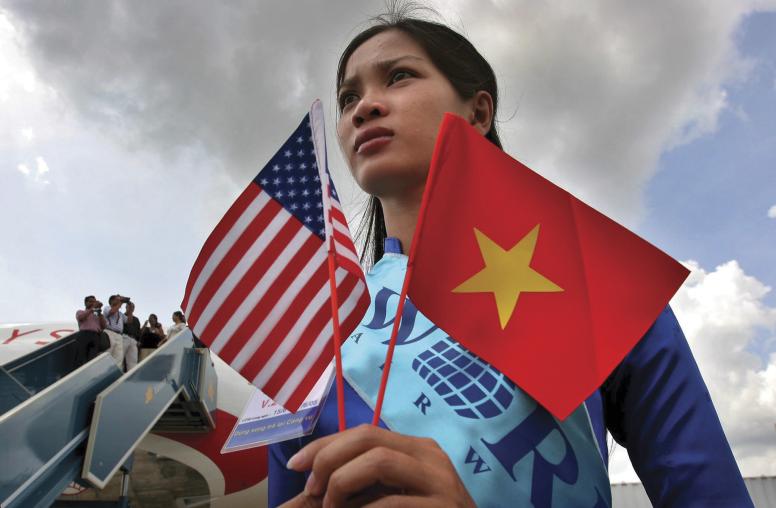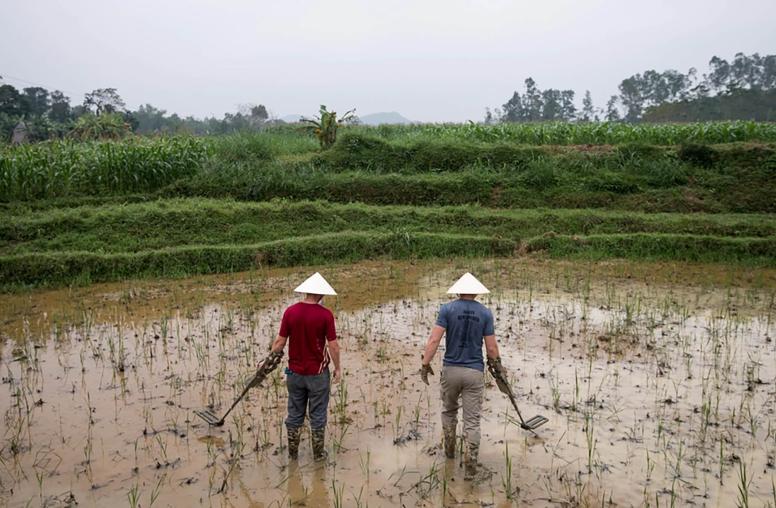Piecing Together the Fragments of Memory to Find Vietnamese War Dead
Search for mass graves aided by U.S. veterans.
Editor’s Note: This piece has been published alongside “It Is Time to Account for All Missing Vietnamese” as part of USIP’s work to offer a comprehensive understanding of war-related recovery and reconciliation efforts in Vietnam.
On the afternoon of March 12, 2022, I received an urgent message from Lâm Hồng Tiên, an engineer and close friend who has dedicated more than a decade to researching Vietnam War documents. He informed me about the discovery of a mass grave of soldiers from the 22nd Regiment of the People’s Army of (North) Vietnam (PAVN) who died in a fierce battle in the early morning of December 27, 1966, in Bình Định province. This was not an ordinary discovery — it resulted from the recollection of some U.S. veterans who buried the soldiers after the battle. I was elated by the finding, as I felt we could do something meaningful with it.

As a TV producer and documentary filmmaker who has made many programs on the Vietnam War, I am no stranger to such stories. What I find most fascinating about them is that after so many years, U.S. veterans’ memories of the war are still clear enough to aid efforts to find the remains of the fallen.
Clues in a Blog Post
It all started with a February 2021 blog post titled “Bad Night at LZ Bird” by Spencer Matteson, a U.S. Vietnam War veteran, in which he described a battle he experienced in the early morning of December 27, 1966. That battle, Matteson writes, “changed me forever.”
In Bình Định province, Landing Zone (LZ) Bird, a U.S. forward artillery base, was overrun by PAVN soldiers from the 22nd Regiment and other local forces. Matteson’s recollection of that battle grabbed the attention of my friends, Lâm Hồng Tiên and architect Nguyễn Xuân Thắng, two of the best researchers I know in Vietnam in this field, as it mentioned mass graves where the U.S. soldiers had buried their enemies and included two photos of the battle site taken by Steve Hassett, another U.S. veteran. Tiên and Thắng then informed the Bình Định Provincial Military Command through a Vietnamese veteran. Local excavation teams in Bình Định province had been searching for these mass graves for a long time, but there was no clue as to where they may be located.
With the information from Matteson and Hassett’s photos, the Bình Định military command was sure that the mass graves were somewhere outside the perimeter of the landing zone, but it was still difficult to locate them. They nearly gave up hope until early last year, when Bob March, a U.S. veteran from the 1st Cavalry Division, helped connect them to some fellow veterans who had seen the mass graves. March spent days and nights collecting detailed descriptions from five U.S. veterans. He provided documents, coordinates and images related to the battle at Xuân Sơn Hill and the locations of the mass graves.
The fragments of memory that the U.S. veterans had wanted to bury had now become a treasure chest that they tried to dig up to help Vietnamese families find some closure. I immediately tagged along for all these efforts and planned to make a documentary.
Bình Định Provincial Military Command authorities successfully excavated the first burial site on March 12, 2022. They recovered the remains of around 60 Vietnamese soldiers and volunteers. The remains were brought back to Tăng Bạt Hổ Town Martyrs’ Cemetery in Hoài Ân district in a solemn ceremony that included state leaders and thousands of veterans, locals and the families of the fallen.
The Search for Mass Graves
Almost 50 years since the end of the Vietnam War, approximately 200,000 North Vietnamese soldiers and southern volunteers (Việt Cộng) are still missing in action, many buried in mass, unmarked graves dug by U.S. service members. The missing have not been forgotten. Their families live with the pain of not knowing their relatives’ fate. In Vietnamese culture, those who have died in war but remain unaccounted for are believed to be lost between this world and the next — wandering in pain and suffering. These spirits can only find peace — and be recognized as heroes — once their remains have been identified and laid to rest.
Last August, with the support of USIP and the help of Vietnamese Col. Trịnh Tùng Lâm, I brought four U.S. veterans — Matteson, Hassett, Ivory Whitaker and Kin Lo — to work with Tiên and Thắng as well as the Bình Định Military Command to search for a second mass grave at what was then LZ Bird, or Xuân Sơn Hill. For some, this was the first time they had returned to Vietnam and the former battlefield since the war. They helped identify the location of the second mass grave. According to their records, this mass grave is situated on the hill’s outskirts, around 200 meters northeast of the first mass grave and contains the remains of around 60 soldiers.
Bình Định provincial authorities are currently excavating in search of the second mass grave. I was able to capture compelling images of this search and the overwhelming emotions of those involved in my documentary, “Fragments of Memory.” I provided a sneak peek of the documentary to some U.S. veterans. Many of them wept, saying they never before realized the significance of the memories they had tried so hard to forget.
Three other U.S. veterans sent me information about the mass graves they saw in Vietnam. I believe there are thousands of veterans out there carrying precious fragments of memory that the Vietnamese are looking for. So, I made a promise to myself that I will try to make my documentary as soon as possible, with the English version available for screening in the United States as a wake-up call for those veterans who may be key to locating mass graves around Vietnam.
Time Is Running Out
While making the documentary, I realized how difficult it is to combine all the available data into one story. It requires not just meticulousness and vast knowledge of battlefield-related research but also a new approach. Information should be exchanged in real time between U.S. veterans and the search teams in Vietnam. It would be ideal if U.S. veterans can be brought to Vietnam to help pinpoint the location of the graves. It is also important that someone serve as a bridge between the veterans and the search teams.
So, Lâm, Thắng, Tiên and I formed a group of four with the hope of being that bridge. Lâm is the deputy director of the Army Broadcasting Center, a standing member of the Vietnam Martyrs’ Families Support Association and a former deputy chief of the Office of the National Steering Committee for the Search and Identification of Martyrs’ Remains (National Steering Committee 515). She has more than 30 years of experience in making television programs to search for fallen soldiers. Thắng and Tiên have a deep understanding of the battles in the Vietnam War and have accessed and analyzed declassified U.S. military information sources as well as information from U.S. veterans to learn about burial places of thousands of Vietnamese soldiers. They have been communicating with many U.S. veterans who have helped complete the records of battles with information about mass graves. This information needs to be verified.
Our group of four has carried out a lot of work in an effort to find information about the burial sites of Vietnamese killed in the war, such as finding mass graves at Biên Hòa Air Base and at former U.S. bases located throughout southern Vietnam.
Our group is dedicated to supporting, sharing and searching for information from Vietnam War veterans; sources of information that the U.S. military has declassified; information from U.S. veterans, social networks and websites; analyzing, filtering and interacting with sources related to fallen Vietnamese soldiers, especially information about places of sacrifice, burial places and mass graves, and then sharing our findings with the relevant agencies so that they can take the next steps. Our group will also collect initial information related to U.S. soldiers killed in the Vietnam War to provide to the Defense POW/MIA Accounting Agency. We hope to receive support to launch a long-term media campaign in both the United States and Vietnam to raise awareness about our efforts.
Time is running out, however. Vietnamese authorities will only excavate in search for solders’ remains based on eyewitness reports, and half a century later, that window is closing fast. The veterans are all growing old. It is now or never. The fragments of memory should form a bigger picture of peace and reconciliation for our people.
Lê Hoàng Linh is a documentary filmmaker and deputy head of the English division at Vietnam Television International VTV4.
“Fragments of Memory” is a documentary about the efforts of Vietnamese search teams and U.S. veterans to find wartime remains after more than half a century. It features an emotional journey, past and present, on both sides, encompassing painful memories to achieve closure and heal war wounds. The Vietnamese version of the film is available here. The English version will be available for screening for the first time during USIP’s annual War Legacies and Peace Dialogue in September in Washington, D.C.



